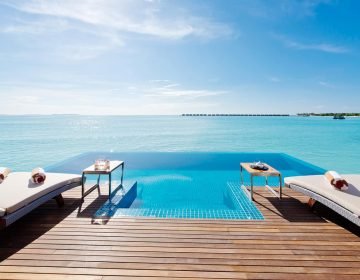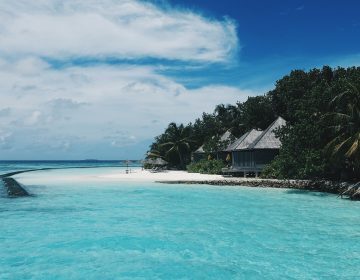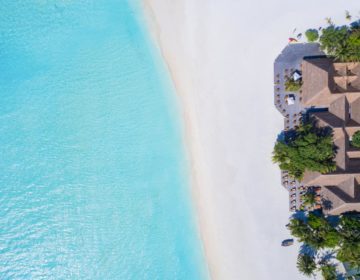The Maldives is opening a new runway and more five-star resorts to keep pace with tourism demand – but can environmental pressures be kept in check?
In the hour before departing Malé, I spotted three Gulf wide-body planes, one Sri Lankan A330, an Aeroflot aircraft, and Air India B737 – all twisting and turning like cumbersome whale sharks around the single, water flanked runway. Velana International Airport is a bit of a time warp, outwardly and inwardly looking as much the same as when I first came here in 2003, though in a commercial sense the Maldives is unrecognizable.
Change is in the air, or more precisely, on the ground. A second runway is complete, adjacent to the first. Etihad sent down an A380 to mark the completion last September, indicating its super-jumbo handling capabilities, but we await an official launch date. A $350 million passenger terminal is also in the offing.
They can’t open too soon. Alongside alleviating operational pressures, adding slots and the prospect of more premium seats, the capacity boost will be equally welcomed by hotel operators and businesses in the hemmed-in capital city, providing foundations for future growths.
Last year’s visitor numbers are expected to weigh in around 1.5 million, and there are now over 130 resorts – with around the same amount in the pipeline.
China, Germany, and the UK spearhead the tourism charge though while the Chinese lead the table with 266,376 visitors, their numbers have been sliding (down 23,000 2018 on 2017) while the UK is on the rise (up 10,625). Sandwiched between the Asian and European titans, the Middle East accounts for a small four percent, but it remains eagerly courted in terms of revenue spends. Gulf carriers are busy funneling European passengers through their Middle Eastern hubs, with loads healthy in the current ‘low’ season as much as the peak December-to-March period.
 Niyama Private Island Maldives
Niyama Private Island Maldives
Chill and Play at Niyama
Our week of escapism began with a seaplane transfer to Niyama Private Island Maldives. We passed a sign advertising Beijing Construction Group – cementing its presence here literally and metaphorically – and stopped off briefly for lunge refreshments before taking off (on the return, transferring to Naladhu, we were escorted to a separate Anantara office-come-lounge inside the terminal which scanned our passports and offered drinks).
As it was the last day of the flight of the day, we touched down at nearby Kandima to drop off two guests. The final leg, barely five minutes, must have been the shortest flight of my life.
The crew member adeptly hopped from plane to raft to plane – the only time in aviation where no-one bats an eyelid seeing someone hanging outside while the aircraft is moving.
This versatile seven-year-old resort, which is divided into ‘chill’ and ‘play’ islands – inscribed on the flip-flops should you forget – is well known regionally and internationally. Initially part of the Per Aquum brand, it’s now a stand-alone within the Minor Hotels portfolio – which majors on the Maldives with three Anantaras: Dhigu, Veli and Kihavah, as well as the exclusive Naladhu, and its fast-growing Avani brand is due to make its Maldives bow this year.
Niyama is a spacious resort, so the bikes outside every villa are useful for exploring both sides, though they have no brakes and some over-eager guests, particularly on the narrower decking on the water villa side, have been known to take an unscheduled dip.
 Niyama Private Island Maldives
Niyama Private Island Maldives
We had the best of both worlds; two nights in the beach villa with pool and direct beach access and one in a water villa which had a pool, jacuzzi, and steps to the ocean – where the only peril was watching out for the coral and rocks underfoot.
We were shown a glimpse of 77, individual central villa separating each side, complete with lounge and long pool – a premium space with rates to match the 180-degree views. Other premium options include stand-alone villas in The Crescent, which command premium prices – ranging from US$17,590 before taxes per night – and popular with Middle East travelers for their privacy.
At the edge-of-resort Surf Shack, I caught up with General Manager Hadifh Busaidy, who was formerly at IHG in the Middle East for 20 years. Niyama’s 134 rooms are only one side of the equation as Busaidy oversees a 504-strong team from 30 countries – an as befits most luxury resort, you would never know, though there are plenty of ‘private’ paths reserved for staff, as you’re cycling around.
“The message I like to get out is the team is extremely genuine – it’s a fun island with lots to do, and we’re family-friendly,” he says.
It’s true. We were warmly welcomed at every turn and even the masseuse popped in to chat to us at breakfast, which I think was a travel first.
In 20 minutes, we cover the importance of waste and energy management; how more biodegradable materials are going in the rooms (e.g. toothbrushes); Minor’s plastic reductions programmes; ongoing maintenance challenges; and crucially, whether you can watch the Champions League final in the middle of the Indian Ocean (you can).
“The biggest question for the Maldives is energy,” he says. “It’s still a little too expensive for resorts to retrofit, but we’re looking at solar power and seeing how viable it is. We try and recycle everything and convert food waste into fertilizer for the gardens.”
Naladhu Exclusivity
One sedate seaplane back to Malé and fast boat ride out later, we disembark at Naladhu – the most exclusive island of three, connected to Anantara Veli (adults only) and across the water from Anantara Dhigu.
Under candlelit dinner on the beach, General Manager Giles Selves says while the Maldives sells itself and remains “massively aspirational,” he predicts next year will be tough. “Back in 2014-15, there was an undersupply and rates were generally higher, but now there’s so much opening and the challenge for established hotels will be competing with the new resorts.”
On the second night, there isn’t a spare seat at the signature Thai Baan Huraa (‘House of Coral’) which stands imperiously between Naladhu and Veli. Staff seems oblivious to the torrential tropical downpour, and for a second I think I’m out at sea. The menu is extensive – as are the names. You could try your luck with ‘Gaeng Poo Bai Cha Ploo gab Sen Mee’ or opt for ‘crab meat with southern curry paste.’
 Subsix at Niyama Private Island Maldives
Subsix at Niyama Private Island Maldives
Waldorf Astoria Joins Premium Resorts Charge
The Maldives has seen a raft of new hotels, stoking the competitive fires in an elongated archipelago already studded with premium hotels.
Newcomers include LUX North Malé Atoll, Raffles Maldives Meradhoo, Riu Atoll (four-star), Hotel Riu Palace Maldives (five-star all-inclusive), Nautilus Maldives, The Residence Maldives, Joali, Hard Rock Hotel Maldives, Faarufushi, Baglioni Resort Maldives, Emerald Maldives Resort & Spa, Waldorf Astoria Maldives Ithaafushi and JW Marriott Maldives Resort & Spa. Westin Maldives Miriandhoo opened towards the end of last year along with Movenpick Resort & Spa Kuredhivaru.
Daniel Welk, Vice President Luxury and Lifestyle, Asia Pacific, for Hilton, is definitely in the pre-opening hot seat. A few weeks prior, I met him in the 50th floor Royal Suite at Waldorf Astoria Dubai International Financial Center – another newcomer this summer – to talk through the brand’s accelerating growth, and four hours south, here he is checking on this new resort which spans 3.5 km. Globally, Waldorf is up to 31 hotels, and 20 more are coming.
“For every Waldorf, location is paramount, and we’re blessed with this location,” he says. “We’re elevating the whole experience – particularly with the private island, which will be a resort within a resort.”
With entry-level villa pools spanning 235 square meters, Welk believes space and privacy that the resort offers consistently throughout is unmatched in the Maldives. Deep-pocketed guests will be able to rent the island for events. “You could have an event for 100 to 150 people, and it wouldn’t detriment the exclusivity that guests receive at the resort.”
 Waldorf Astoria Maldives Ithaafushi
Waldorf Astoria Maldives Ithaafushi
For a brand with an 88-year legacy, Waldorf is now riding the development wave. Welk maintains Waldorf Astoria can be a “pioneer for tomorrow’s travelers”- though he’s keen to stress it remains faithful to its core service principles.
“You can’t look in the rear-view mirror all your life,” he added. “Luxury travel is changing rapidly across Asia-Pacific, and travelers are seeking experiences more than ‘things.’ Digital enhances the hospitality experience, but it doesn’t take it over – ultimately we’re in the business of people serving people.”
As the saxophonist plays Your Latest Trick in the quiet but airy Peacock Alley, General Manager Etienne Dalancon said it marks the first luxury resort close to Malé for many years.
“We have 24-hour transfers, so there’s no headache,” he said. “When we talk about luxury, it’s about time, space, and choice. You can stay in your villa’s pool or meet in the main pool and dine differently every night.”
He is confident the private island will be occupied for “at least 15 days a month” driven by interest from the Middle East, Russia, and China. In time, it will look to offer twin stays with the Conrad Rangali.
Reconciling Tourism and Conservation
If ever a destination sums up the challenges of global tourism growth, it must be the Maldives. More travelers bring more dollars but also more strains to an environment on the front line of global warming. No island is taller than 2.4 meters – and it’s not just rising sea levels which are a concern, but all the associate marine challenges, from over-fishing to pollution.
In out three-resort stay, the state of the coral looked patchy; good in parts, bleached in others. The recovery remains slow, 15 years after the tsunami. Having watched recent TV reports from Seychelles, I boarded the flight with some trepidation – but over a week, I fished out one yellow rubber glove and a small blue plastic bag. The clarity of the turquoise waters, even in low season, is remarkable.
We saw innumerable crabs larger than outstretched hands, dozens of dolphins, swam with nurse sharks, stumbled upon a turtle and snorkeled among hundreds of fish. There is much to celebrate and protect.
The Maldives government, working with hotels, has levied a $6 green tax against every visitor per night stay, which is channeled into conservation. Scientists increasingly stark forecasts leave little room for complacency, but there is hope for the Maldives.

Article: Dominic Ellis, Business Traveller Middle East



